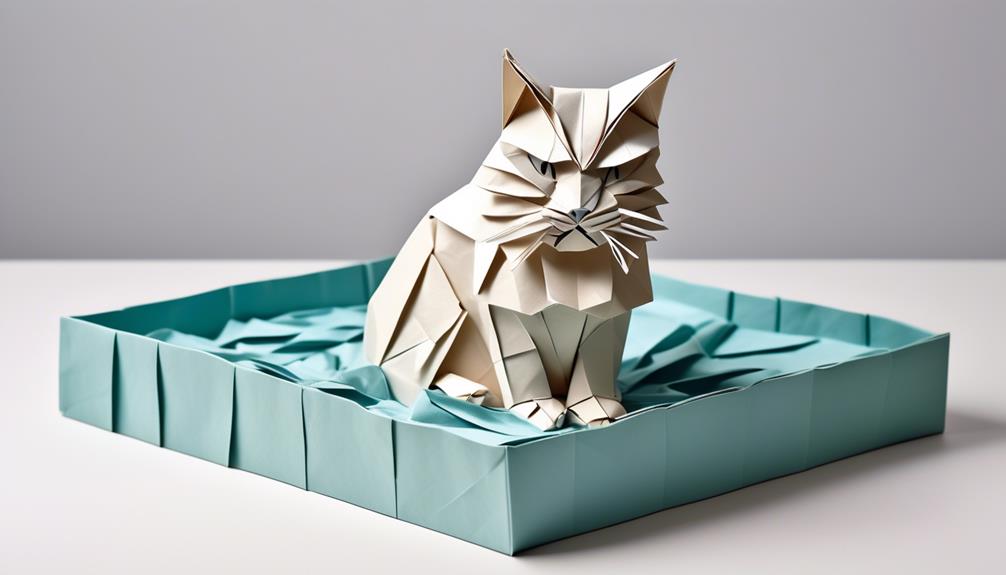Your cat, who used to be very active, is now moving more carefully because they are getting older. You have also noticed that they are having difficulty using the litter box, which indicates there might be a health problem.
It’s not uncommon for older cats to face the painful reality of urinary blockages, a condition that tugs at your heartstrings as you watch them suffer. You’re not alone in this; urinary issues are a serious, yet common ailment afflicting older cats. Their once efficient plumbing, much like the pipes in an aging house, can become clogged and require urgent care.
You want to understand and manage your senior cat’s urinary health issues to make their later years more comfortable. It’s important to know why these blockages occur and how to ease their discomfort.
Key Takeaways
- Urinary blockages in older cats can be caused by urethral plugs, urinary stones, inflammation, cancer, FIC, FLUTD, and dietary factors.
- Symptoms of urinary blockages include straining to urinate, frequent trips to the litter box with difficulty passing urine, and blood in the urine.
- Diagnosis of urinary blockages involves a physical examination, medical history, urinalysis, imaging tests such as X-rays, ultrasound, CT scans, and blood tests.
- Treatment options for urinary blockages include catheterization, medications, intravenous fluids, and surgical options for recurrent obstructions or underlying causes.
Understanding Urinary Blockages
While it’s often a distressing condition, understanding urinary blockages in your older cat is the first step to ensuring they receive prompt and effective care. You might’ve heard of urethral obstruction, a serious form of lower urinary tract disease. It’s more common in male cats, whose narrower urethras heighten their risk. The causes of urinary blockage can range from urethral plugs made up of protein and crystals, to urinary stones, inflammation, and on rare occasions, cancer.
It is essential to quickly unblock the urinary tract. This often requires inserting a urinary catheter, hospitalization, and additional supportive care. For cats with recurring blockages, surgery such as perineal urethrostomy might be necessary. This emergency procedure can be lifesaving.
Feline idiopathic cystitis (FIC) is another condition that may contribute to urinary issues. To prevent such emergencies, ensure your cat has access to fresh water and a balanced diet. Regular exercise and monitoring litter box habits can help, too. Early detection through consistent veterinary check-ups is key.
Symptoms to Observe
Recognizing the signs of urinary blockages in your older cat is vital, as early detection of symptoms can lead to timely and lifesaving treatment. As a compassionate caregiver, you’ll want to keep a watchful eye for any changes in your cat’s bathroom habits.
Symptoms of a urinary blockage, a serious condition, can sometimes be subtle but are essential to spot. Your older cat may experience urinary tract infections (UTIs), which could lead to a urinary blockage. You might notice them straining to urinate, a sign that they’re experiencing discomfort. This straining could be a symptom of a larger issue, such as Feline lower urinary tract disease (FLUTD) or urethral obstruction.
It’s also common for affected cats to make frequent trips to the litter box yet have difficulty passing urine. Be on the lookout for blood in the urine, another alarming sign. It’s not something to take lightly, as it can indicate inflammation or infection.
If you observe any of these symptoms, it’s essential to act swiftly and seek veterinary care. Prompt attention to these signs can prevent further complications and help ensure your older cat continues to live a comfortable and happy life.
Common Causes Explained
You might find it worrying when your beloved cat faces urinary troubles, and understanding the common causes can ease your mind.
The Feline Lower Urinary Tract Disease (FLUTD) and dietary factors play significant roles in these blockages.
Let’s take a closer look at how these elements can affect your cat’s health and what you can do to help.
Feline Lower Urinary Tract
Understanding the common causes of Feline lower urinary tract issues is essential, as it can be a matter of life and death for your cherished older cat. Cat urinary blockages often stem from urinary crystals or stones that form within the urinary bladder, leading to urethral obstruction.
These blockages can cause distressing symptoms such as frequent attempts to urinate, increased thirst, and decreased appetite. Prompt attention from a trusted College of Veterinary Medicine is vital to alleviate urethral blockage through treatments like restoring electrolyte balance and carefully passing a urinary catheter.
To protect your aging cat, preventive measures are key. A special urinary diet, regular veterinary check-ups, reducing stress, and ensuring they’re well-hydrated can help manage urinary issues and prevent future occurrences.
Dietary Influence Factors
While your beloved cat’s diet might seem adequate, certain foods high in magnesium can inadvertently lead to urinary blockages, a serious health concern for older felines. If you’re noticing your cat struggling with Feline urinary issues, it’s time to consider the impact of their diet.
A prescription diet tailored to maintain a healthy urine pH and low minerals in the urine can improve urinary health and prevent cat urinary blockage.
Incorporating dietary changes, such as increasing water consumption through wet or canned food, can also be beneficial. These foods not only hydrate but also promote a lower urinary pH, helping to dissolve any problematic crystals.
Diagnostic Procedures
You’re understandably worried when your older cat isn’t themselves, and urinary blockages can be a serious concern. Diagnostic procedures are essential because they accurately identify the problem and help determine the appropriate treatment.
We’ll walk through identifying obstructions, explain imaging tests, and break down what urinalysis can tell us about your cat’s health.
Identifying Urinary Obstructions
When your beloved older cat begins to show signs of discomfort or difficulty while urinating, it’s important to promptly identify any urinary obstructions through a series of diagnostic procedures. A thorough physical examination and medical history are foundational in spotting these urethral blockages. Your vet may note clinical signs during a gentle palpation of your cat’s abdomen. If your cat is visiting the litter box frequently or making multiple trips to the litter without much success in trying to urinate, it’s a red flag.
Urinalysis is imperative for assessing urinary health, looking for blood, crystals, or signs of infection that can point to a urethral obstruction. X-rays or ultrasound will help visualize any bladder stones or tumors affecting urine flow. Blood tests evaluate kidney function to ensure this serious condition hasn’t compromised your cat’s overall health. If blocked, urethral catheterization might be necessary to relieve your cat’s distress.
Imaging Tests Explained
Understanding the distress your older cat may be experiencing, it’s essential to essential the various imaging tests that can provide a clearer picture of what’s happening inside their little body. These tests can reveal if a blockage in the urethra is causing their urinary conditions.
| Test | Purpose |
|---|---|
| Abdominal X-ray | Detects stones, tumors, or structural problems in the lower urinary tract |
| Ultrasound | Provides a detailed view of the bladder and urethra |
| CT Scan | Offers a comprehensive cross-sectional image to locate blockages |
| MRI | Visualizes soft tissues and can identify complex issues |
| Nuclear Medicine | Evaluates organ function, particularly the kidneys’ ability to filter waste |
Blood work, in conjunction with these imaging tests, helps the College of Veterinary Medicine professionals understand your cat’s urinary health. Together, these tools ensure your beloved cat gets the best care for their needs.
Laboratory Urinalysis Breakdown
A urinalysis is a crucial diagnostic test for identifying the causes of urinary problems in older cats. It provides valuable insights into your cat’s urinary tract health.
- Crystal Clarity: Detects crystals that could lead to urethral blockage, ensuring your cat’s path to wellness is clear.
- Infection Inspection: Identifies any sign of infection, offering peace of mind that every issue is being addressed.
- Concentration Compassion: Measures urine concentration, signifying how well the kidneys are functioning and guiding further care.
- pH Balance: Determines urine pH, which can affect crystal formation and tract health.
With each finding, your dedication to your cat’s litter box comfort and overall well-being is deeply honored.
Available Treatment Options
If your older cat has a urinary blockage, there are many treatments to help. This emergency condition needs quick vet attention to avoid severe complications and ensure your cat’s recovery.
Your vet might suggest catheterization to remove the blockage and reduce your cat’s pain, which is essential for its health. They may also give medications like antibiotics, pain relievers, and drugs to relax the urethra for easier management.
Intravenous fluids are often part of the treatment plan during hospitalization. They play an important role in flushing out uremic toxins and providing the supportive care your cat needs during this challenging time.
For recurrent urethral obstructions or specific underlying causes such as bladder stones, your veterinarian might discuss surgical options with you, including PU surgery, to prevent future occurrences.
Always remember, proper treatment can save your cat’s life and restore their quality of living. Your prompt action and compassionate care make all the difference.
Post-Treatment Recovery
After seeing your cat through treatment for a urinary blockage, it’s important to focus on their recovery to ensure a return to comfort and health. The blockage is a painful ordeal, and your cat will likely need your tender care and attention more than ever during this delicate time.
Here’s how you can help:
- Monitor Them Closely: After the catheter, which was left in place to bypass the urethral sphincter and allow urine to exit the body, is removed, watch for any signs of distress or difficulty as they pass urine.
- Encourage Hydration: Provide a diet rich in moisture, perhaps with wet food, and ensure fresh water is always available to maintain their urinary health.
- Medication and Diet: Faithfully administer any prescribed medications and follow the special diet recommended by the vet to prevent future issues.
- Create a Haven: Set up a calm, quiet space for your cat to recuperate, away from the hustle and bustle of daily life.
Prevention Strategies
To safeguard your beloved cat’s urinary health, it’s essential to adopt preventative measures that can avert the distress of blockages and maintain their well-being. Prevention strategies play an important role in supporting your cat’s urinary health.
Make sure to provide access to fresh water at all times, as staying hydrated helps to prevent the formation of crystals that can lead to blockages, particularly in the narrow male urethra.
Feed your cat a balanced diet formulated to promote urinary health; this can reduce the risk of blockages in cats by minimizing the development of urinary stones. Encourage regular exercise to help manage weight and support overall health, which is beneficial for their urinary system too.
Monitor your cat’s litter box habits, as changes can indicate the onset of Feline idiopathic cystitis or other urinary issues. It’s wise to have one more litter box than the number of cats in your home to encourage frequent urination and reduce stress.
Schedule regular veterinary check-ups to catch any early signs of potential urinary blockages. By following these compassionate care practices, you’ll be taking meaningful steps to protect your cat’s health.
Monitoring Senior Cat Health
While you’re implementing these preventative measures, it’s also vital to keep a close eye on your older cat’s daily habits and health indicators. Monitoring senior cat health goes beyond the routine—you’re safeguarding a cherished cat from potential pain and distress.
Here’s what you should watch for:
- Observe Water Intake: Ensure your cat stays hydrated. A decrease could signal kidney issues.
- Litter Box Habits: Note the frequency and any changes in urine output, which could indicate bladder concerns.
- Signs of Discomfort: Watch for any straining during urination, a possible sign of urinary blockages.
- Veterinary Visits: Schedule regular check-ups. A thorough physical examination can detect early signs of feline idiopathic cystitis or other conditions lowering your cat’s quality of life.
Frequently Asked Questions
Why Does My Cat Keep Getting Urinary Blockage?
You’re baffled as your cat becomes a repeat offender in the urinary blockage department. It’s a heart-wrenching cycle, but remember, they rely on your care to steer clear of such painful predicaments.
How Do You Prevent Blockages in Cats?
To prevent urinary blockages in your cat, always provide fresh water, feed a balanced diet with wet food, encourage exercise, monitor their litter habits, and schedule regular vet visits for their well-being.
What Is the Survival Rate for a Cat With a Urinary Blockage?
You’re likely worried, but know that cats with urinary blockages can often survive if they’re treated quickly. It’s important to act fast to avoid complications and ensure your cat’s best chance at recovery.
Can Cat Litter Cause Urinary Blockage?
Some types of cat litter can lead to urinary blockages, particularly in older cats. It is very important to select a litter that is safe and supports urinary health for your cat’s well-being.




